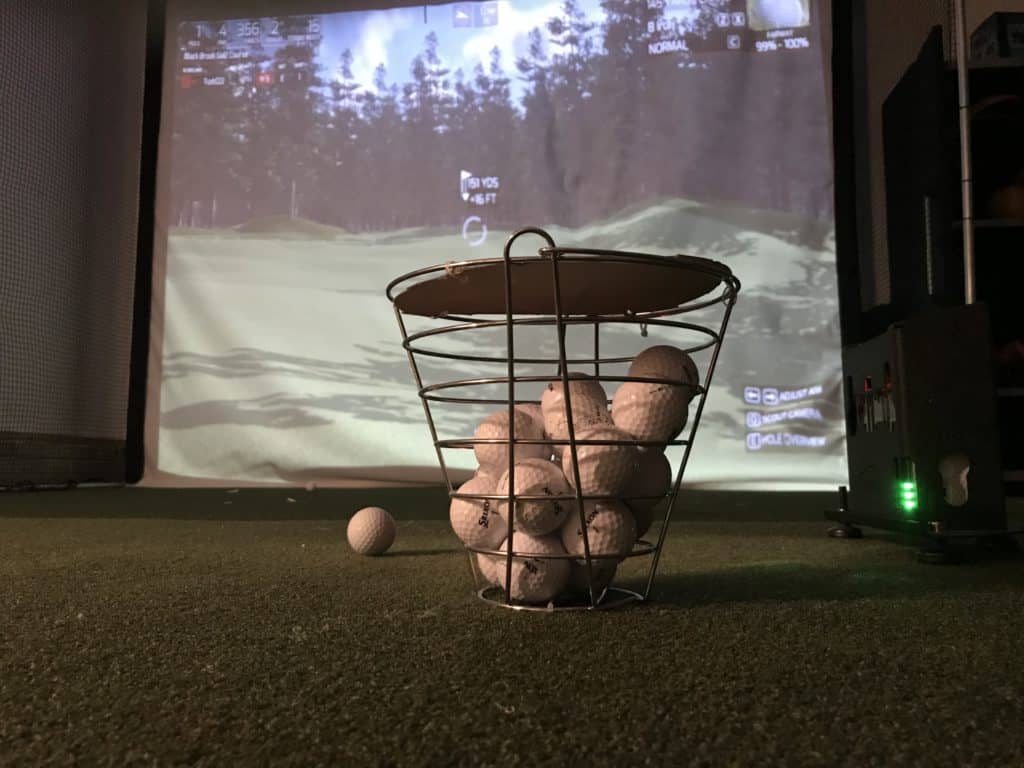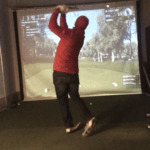There is nothing worse in golf then all of a sudden loss of distance in golf.
Whether it is the driver and now you are playing from much further back or you leave an iron shot way short and in a hazard, these are the swing faults that start to impact the golf score and can make the game of golf frustrating for some.
Golf can be a crazy game and everything seems to be going well and then all of a sudden mid round, things start taking place. One issue people have is the inconsistency with the distance they hit each club.
Below, I will dive into the 7 checkpoints and the most likely causes of a sudden loss of distance.
Whether you are mid round or post round, you can use this checklist to make a quick fix on the golf course or at the driving range and make sure you can complete your round successfully or take the right swing to the course the next time.
Golf is a journey, keep in mind that there is no such thing as perfection, only progress. Work to make that progress every day, week and season to help reach the goals that you have for the game.
Every golfer wants to hit the ball better and hit their best shots more often. This checklist below can help you become an overall better golfer and the checkpoints often are items that can help with other swing faults!

Potential Causes Of A Sudden Loss of Distance With Driver:
- Not completing your turn
- Casting the club from the top
- Tempo has become too slow
- Your grip has weakened over time
- Slowing down before impact
- Trying to direct the ball
- Speed in the wrong place
Checklist Item #1: Not Completing Your Turn
One of the most important parts of any golf swing when it comes to speed is the ability to make a complete turn. If you fail to turn your hips and shoulders enough, not only do you cut down on potential speed in your swing, but many other issues can start to creep in.
Make sure you take a quality setup, one where your arm points are over the balls of your feet, and you are bit upright. Make sure you don’t stick out your behind too much or you will lock yourself into a positions where you can’t make a complete turn.
Your shoulder turn rotate or turn about 90 degrees and your hips should rotate or turn around 45 degrees. Most golfers can make this turn if they aren’t restricting movement in the golf swing.
If this means your front foot has to come slightly off the ground, no problem at all!. Just ensure that you have a complete turn each and every full swing. This is the number destroyer of speed in your swing, not making a full turn.
You have to be able to load up and turn before you can fire on your downswing!
Tip:
Take a video of yourself with your smartphone from the side view. Check at the top of your swing how much of a turn you have made with your shoulders and hips.
If you are short of 90 and 45 degrees do exaggeration drills. Don’t worry about where the ball goes, just focus on making that complete turn on the backswing!
Check out this George Gankas video on making a complete turn in the backswing.
Checklist Item #2: Casting The Club From the Top
If you watch any professional golfers swing a golf club you will see a full turn and then sequencing that allows the legs, hips, shoulders and upper body move out of the way and sling the club throught the hitting zone. They fire away and the sequence happens pretty naturally.
If you are casting your club from the top, which means you are letting go of all of your lag, you will lose some significant power. This can happen based on what you are focused on. If you are focusing on hitting the ball, you will become ball centered and could throw your lag early or cast.
Instead, check out the Shawn Clement video below and have your focus be more target based. Think of throwing the club down the fairway and this will help you star within the shot and not throw the angles away within the first 12 inches of the downswing.
Tip:
Once again take a video of your swing and see if you are casting early from the top and then check out these two videos below to gain some insight and some drills you can use if this is your issue.
Checklist Item #3: Tempo Has Become Too Slow
Once again, golf is not a game of perfection. Sometimes in an effort to be perfect and hit all of the positions in the golf swing, a golfer can actually slow his or her swing down.
They are too focused on making the perfect swing, instead of swinging tension free and maintaining the swing. Some of the most eye opening information I have seen is the work by John Novosel Jr. and Swing Tempo.
Did you know that the best golfers utilize a 3:1 ration in backswing to downswing. The best golfers in the world have a 24:8, 21:7 and sometimes as fast as an 18:6 swing tempo. The old days and advice of taking a long and slow backswing is not good advice. In fast, many poor amateur golfers might have a swing ratio close to 40:11.
Speed and distances comes from speed within the swing. If you want to hit the ball further, try increasing the speed of your backswing.
Tip:
Use the Tour Tempo app to time your swing and see what ratio you are swinging at. Check out John Novosel Jr. and his work and training aids to help you swing the right tempo.
Checklist Item #4: Your Grip Has Weakened Over Time
If you are struggling with overall ball contact or distance issues, make sure you check your grip. You want the grip to be in your fingers vs your palms and check to see how strong your lead arm is. Over time, some golfers may weaken their grip, which could be a cause of a loss of distance.
If you check out many of the grips on tour today, you will see strong grips. This is because distance and speed is so vitally important to them. A strong left grip, gives you a feeling of power and allows the club to rotation through the swing and maximize your distance.
Tip:
Once again, take a video from the side and see where your grip is at. Experiment with different grips and see if you have an increase in distance.
Checklist Item #5: Slowing Down Before Impact
Oftentimes as a round progress and a golfer is playing well he or she might want to maintain everything that they are doing. They start to try to manipulate the swing and make everything perfect in their downswing and end up slowing down prior to impact.
This can lead to disaster. Not only will the golfer lose significant distance, but he or she might also struggle with solid ball contact, further reducing the overall distance.
The best golfers have speed right at impact and beyond. If you think of moving your speed past the ball, this will help maximize the speed in your swing.
Tip:
Work on getting the speed at the ball and beyond. You want to maintain the speed through the ball and not stop at the ball.
Checklist Item #6: Trying to Direct the Ball
The next issue as a round progress that can lead to sudden loss of distance with the driver is trying to control the direction of the ball on the downswing. Golfers have a tendency to try to direct the ball and control and prevent bad shots.
Instead, the golfer needs to get the feeling that they want in the swing and step up to they ball and trust the swing. Playing golf scared can lead to some tension, and slowing down through the shot, but keep in mind that a manipulated swing often does not produce quality shots.
Once again, I refer back to Shawn Clement and allowing gravity and the great system that our human anatomy is to make a swing that is focused on the target and allows the golfer to swing without tension and fear of where the ball might go.
Tip:
Work on having your swing feel and though, rehearse it and then step up the ball and live with the results. If you try to manipulate the outcome, you will more than likely fail. So you might as well trust the swing and the feeling and let it go!
Checklist Item #7: Speed in The Wrong Place
This checklist item is more an overall view of what is taking place in the swing. As we shared earlier, the speed needs to be at the ball and beyond. The speed too early in the downswing will lead to poor results.
This reason is a slightly different than #5 and can be a result from a golfer rushing from the top of the swing. Instead, let the swing gather and then throw the club hard through impact. Let go, but don’t let go too early. Instead wait in the downswing and throw the club towards the target!
Tip:
Work to allow the body to set itself early in the downswing and then fire away. I love the teaching of George Gankas on this topic. There is a slight squat and then a turn and firing of the club.
Here is a great video by George Gankas on letting the arms fall instead of pulling the arms from the top:
How To Measure Your Golf Swing?
One of the greatest things about living in today’s golf world is the access to some affordable technology that can be a game changer in your golf game and life. For years, golfers tried to find “the secret in the dirt,” but now golfers can have immediate feedback on the followings items:
- Ball Speed
- Club Speed
- Launch Angle
- Spin Rate
- Spin Axis
How might a golfer have this information? Through an affordable golf launch monitor. Being able to measure your swing at the driving range, on the golf course, or in a home golf simulator setup is a game changer.
In all learning, immediate feedback and data can be helpful to help improve your swing or to keep your swing on track!
Here are three launch monitors that I would recommend (Between 500 and 2000 dollars):
A golfer can spend up to $16,000 on a device like a Trackman or other high end launch monitors, but the more affordable options listed above work for most golfers!
The accuracy when compared to the top models is within a quality range and a device like the SkyTrak can also allow a golfer to build a golf simulator setup and use the launch monitor in multiple settings.
Where Can I Use A Golf Launch Monitor?

Final Thoughts: My Secret To Golf Improvement
Let’s face it, in order to get really good at golf, we must practice frequently. About three years ago, I made the leap and invested in a golf simulator build for my garage.
I went with a SkyTrak Launch Monitor and the TGC software and can now play over 100,000 courses including Augusta, Pebble Beach, Bethpage Black, Whistling Straits. St. Andrews and many other of the top 100 courses in the world.
TGC is amazing software – Read a Full Review Here
This golf simulator setup, which is more affordable that you might imagine, has been a game changer. I can now play golf everyday of the year regardless of rain, snow, cold weather or time of day.
I can practice or play rounds of golf. I can stand in the 11th fairway at Augusta and with the auto-rewind feature I am able to practice my approach shots from various differences.
It is worth checking out through Rain or Shine Golf as they offer some incredible packages along with financing offers that are difficult to beat.
Some direct links to Rain or Shine Golf for pricing and financing:
How To Gain More Distance With Your Driver
I would highly recommend overspeed training. Over the past year I have spent time working with SuperSpeed Training system. Their their club system where the golfer follows protocols is a game changer. There are different speed training systems on the market.
Check out the price on Amazon here:
Another option if this won’t fit into your game is Swing Man Golf (see link below)
Gain 30-40 yards in 30 Days – Swing Man Golf
Take Action – What You Can Do Today to Get Better
What does this mean for you? I believe in the following recipe to get better:
1 – Improve your motion in the golf swing by identifying a golf instructor. Here are some options:
Here is a list of golf instructors that we have reviewed:
2 – Train to swing faster and improve your swing speed. Here are some options:
Looking to gain more Speed and Distance in your swing. Two Options:
3 – Understand course strategy and work to break through your next barrier. Here is a series on breaking through:
We have provided guides on how to break 100, 90, 80 and 70. Check out more below, if interested.
4 – Practice Frequently
Did you know that I build a golf simulator in my garage and have played over 500 rounds of golf on my SkyTrak system? It has been a game changer and one worth checking out. Here are some of my other posts on golf simulators frequently asked questions:
- Is a Golf Simulator Worth It?
- How to Build a Golf Simulator?
- What is the Best Golf Simulator?
- Golf Simulator Accessories?
- How to Build a Golf Simulator for under $7000
- Top 11 Reasons to Buy a SkyTrak
- How to Build a Golf Simulator for Under $1000
- Why Build A Golf Simulator?
- What Space is Needed?
- Can A Golf Simulator Improve My Game?
- How Much Does A Golf Simulator Cost?
- Don’t Forget to Check out our 15 best golf swings of all time.
I am an amateur golfer on a journey to get better, enjoy the game as often as possible and share my passion and knowledge with others. I have coached high school golfers at a high level and have a great passion for the game and want to give back. I enjoy learning about the golf swing and am currently studying to be a certified professional golf instructor. Join me in our journey to get better everyday.

